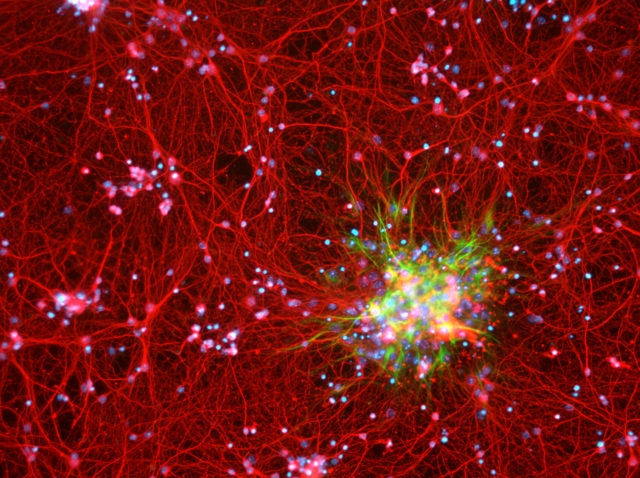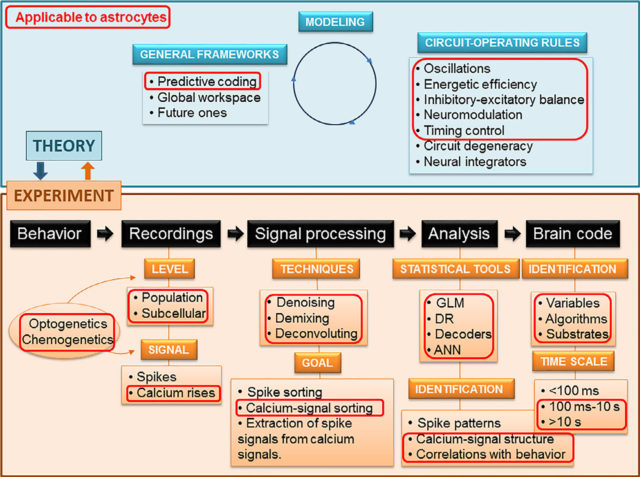How to integrate astrocytes into systems neuroscience

The computer metaphor draws an analogy between the mind as software and the brain as hardware. In this metaphor, the focus of discussions is usually on the software part, taking for granted that the brain, or the whole nervous system, is a computer of sorts. But this is something that needs to be proved first. At least we should be able to simulate what the brain does – any function would do. In other words, we need to understand the realization of brain-related functions at the level of organization that can be captured by logico-mathematical models, such as those describing man-made systems, for example, computers.
Enter systems neuroscience. It is a subdiscipline of neuroscience and systems biology that studies the structure and function of neural circuits and systems. It is an umbrella term, encompassing a number of areas of study concerned with how nerve cells behave when connected together to form neural pathways, neural circuits, and larger brain networks. The overarching goal of systems neuroscience is to understand how neural circuits give rise to cognitive functions, emotions, and behavior by simultaneously recording neuronal activity and behavior at the highest spatiotemporal resolution possible.
If we pay attention, it looks like systems neuroscience is solely focused on the wiring – in this context, read neurons – and the fact is that it is almost exclusively a neuronal/neural discipline. But, using the computer metaphor, no CPU+memory works in a vacuum: it needs an electrical supply system, a homeostatic (cooling) one and mechanical support and protection. Therefore, it is reasonable to think that any simulation of the brain may not work properly unless the equivalent auxiliary systems are included if they have some computational effect.
The scarce attention to non-neuronal cells in systems neuroscience is puzzling, at least if we consider what astrocytes do. Astrocytes are star-shaped glial cells that delivers “fuel” to the neurons from the blood, removes waste from the neuron, and otherwise modulates the activity of the neuron. Astrocytes also play critical roles in brain development and the creation of synapses. Research since the mid-1990s has shown that astrocytes propagate intercellular Ca2+ waves over long distances in response to stimulation, and, similar to neurons, release transmitters (called gliotransmitters) in a Ca2+-dependent manner. Data suggest that astrocytes also signal to neurons through Ca2+-dependent release of glutamate. Such discoveries have made astrocytes an important area of research within the field of neuroscience.
Although extensive modeling of astrocytic Ca2+ fluxes exists, and sporadic studies have explored the application of astrocyte-based computations to artificial intelligence, astrocytes are characteristically missing from advanced in silico modeling of neural circuits. The point is, if computation is an emerging property of a given neural network, do astrocytes help to shape such property beyond providing metabolic and homeostatic support? If they do, specific questions are whether there are niche(s) in systems neuroscience that would particularly profit from astrocyte idiosyncrasies and whether the impressive techniques and theoretical weaponry deployed by systems neuroscience could be used—and are sufficient—to unravel possible astrocyte-based computations.

A new review 1 by an international team of researchers, including Maurizio De Pittà (BCAM), comes to clarify the situation.
The researchers review systems-like studies that include astrocytes in order to identify computational operations that these cells may perform, using Ca2+ transients as their encoding language. The analysis suggests that astrocytes may carry out canonical computations in a time scale of subseconds to seconds in sensory processing, neuromodulation, brain state, memory formation, fear, and complex homeostatic reflexes.
They propose a list of actions to gain insight into the outstanding question of which variables are encoded by such computations. The application of statistical analyses based on machine learning, such as dimensionality reduction and decoding in the context of complex behaviours, combined with connectomics of astrocyte–neuronal circuits, is, in thir view, fundamental undertakings.
The review would not be complete without discussing technical and analytical approaches to study neuronal and astrocytic populations simultaneously, and the inclusion of astrocytes in advanced modeling of neural circuits, as well as in theories currently under exploration such as predictive coding and energy-efficient coding.
Clarifying the relationship between astrocytic Ca2+ and brain coding may represent a leap forward toward novel approaches in the study of astrocytes in health and disease.
Author: César Tomé López is a science writer and the editor of Mapping Ignorance.
References
- Ksenia V. Kastanenka, Rubén Moreno‐Bote, Maurizio De Pittà, Gertrudis Perea, Abel Eraso‐Pichot, Roser Masgrau, Kira E. Poskanzer, Elena Galea (2019) A roadmap to integrate astrocytes into Systems Neuroscience Glia doi: 10.1002/glia.23632 ↩